FAQ: Does AFFF Cause Cancer?
- Last Updated: June 12th, 2025

Attorney Jessica Paluch-Hoerman, founder of TruLaw, has over 28 years of experience as a personal injury and mass tort attorney, and previously worked as an international tax attorney at Deloitte. Jessie collaborates with attorneys nationwide — enabling her to share reliable, up-to-date legal information with our readers.
Legally Reviewed
This article has been written and reviewed for legal accuracy and clarity by the team of writers and legal experts at TruLaw and is as accurate as possible. This content should not be taken as legal advice from an attorney. If you would like to learn more about our owner and experienced injury lawyer, Jessie Paluch, you can do so here.
Fact-Checked
TruLaw does everything possible to make sure the information in this article is up to date and accurate. If you need specific legal advice about your case, contact us by using the chat on the bottom of this page. This article should not be taken as advice from an attorney.
Key takeaways:
- AFFF, or aqueous film-forming foam, has been linked to potential cancer risks due to the presence of toxic per- and polyfluoroalkyl substances (PFAS) in its composition, highlighting the need for further research and regulation to protect public health.
- The use of AFFF in firefighting and other industries has raised concerns about the long-term health effects, including cancer development, associated with exposure to PFAS compounds, urging authorities to consider alternative fire suppression methods.
- Understanding the potential cancer-causing properties of AFFF is crucial for firefighters, industrial workers, and the general public, emphasizing the importance of implementing preventative measures and exploring safer alternatives to minimize health risks.
Does AFFF Firefighting Foam Cause Cancer?
Question: Does AFFF cause cancer?
Answer: Numerous studies have found a connection between long-term exposure to AFFF (Aqueous Film Forming Foam) and an increased risk of developing cancer.
AFFF contains harmful chemicals known as per- and polyfluoroalkyl substances (PFAS), which can build up in the human body over time and cause cellular damage.
These PFAS chemicals have been linked to several types of cancer, including:
- Non-Hodgkin’s lymphoma
- Breast cancer
- Prostate cancer
- Liver cancer
- Leukemia
- Bladder cancer
- Kidney cancer
- Ovarian cancer
- Lymphoma
- Pancreatic cancer
- Testicular cancer
Other harmful side effects of AFFF exposure may include:
- Immune system deficiencies
- Increased cholesterol levels
- Thyroid disease
- Fertility issues
- Child developmental delays
- Preeclampsia and hypertension during pregnancy
- Liver damage
- Asthma
- Birth defects
The greatest risk of a cancer diagnosis due to AFFF exposure is faced by those who have been exposed for extended periods, often without being fully aware of the potential dangers.
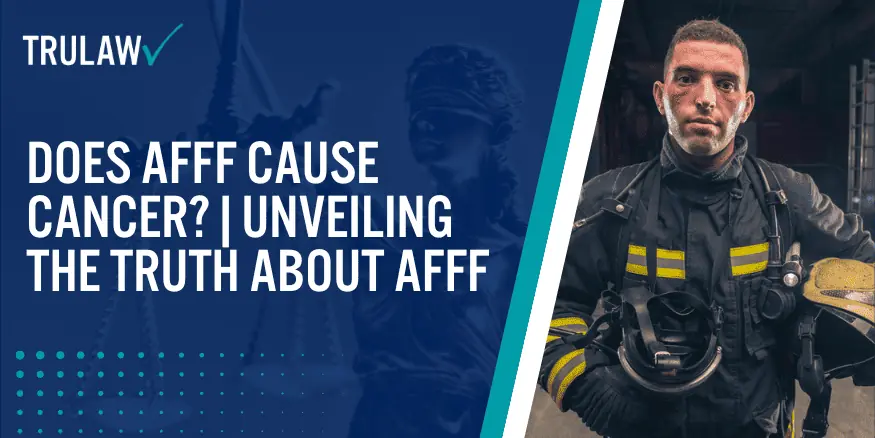
Firefighting Foam Lawsuits Sparked by AFFF Side Effects & Health Risks
Individuals who were exposed to toxic firefighting foam and later developed cancer or other health issues are now filing AFFF Firefighting Foam Lawsuits against the manufacturers responsible for these chemicals.
PFAS chemicals, commonly used in the production of certain AFFF firefighting foams, have been tied to severe health conditions such as kidney and testicular cancer, thyroid disease, liver damage, immune system problems, and more.
This page aims to bring awareness to the serious side effects and health risks associated with AFFF exposure.
By understanding these risks, those affected can make informed decisions about protecting their health and pursuing justice.
Additionally, we will discuss the importance of working an experienced AFFF law firm to file lawsuits against responsible manufacturers, seeking financial compensation for the damages caused by these dangerous chemicals.
If you or a loved one were exposed to toxic firefighting foam and have since developed cancer or other health conditions, you may qualify to file an AFFF lawsuit.
Contact us today for more information by using the chatbot on this page to see if you qualify for an AFFF lawsuit instantly.
An experienced firefighting foam attorney at TruLaw is here to help firefighting foam cancer victims through the legal process and ensure their damages are addressed.
If you believe AFFF exposure has affected your health, reach out to TruLaw to learn more about the next steps.
Table of Contents
Harmful Chemicals in AFFF Firefighting Foam Tied to Cancer and Other Health Problems
Aqueous film-forming foam (AFFF) is commonly used to combat flammable liquid fires.
Unfortunately, many of these foams contain toxic chemicals known as perfluoroalkyl and polyfluoroalkyl substances (PFAS).
These chemicals are highly resistant to heat, oil, and water, which makes them effective in firefighting, but they have also raised influential concerns due to their persistence in the environment and potential health risks.
PFAS, often called “forever chemicals,” have been shown to contaminate air, water, soil, and even food sources.
The Environmental Protection Agency (EPA) has identified serious potential health risks from exposure to these substances.
Studies have found traces of PFAS chemicals in the bloodstream of both humans and animals, which raises further alarms about their widespread impact.
The Centers for Disease Control and Prevention (CDC) has reported that exposure to PFAS has been linked to several health problems, including liver damage, thyroid disease, reproductive issues, and weakened immune system function.
PFAS can enter the body through ingestion, inhalation, or skin contact, increasing the risk of serious health consequences.
The Agency for Toxic Substances and Disease Registry (ATSDR) echoes these concerns, citing animal studies that reveal PFAS can cause liver and immune system damage, birth defects, and developmental delays.
These studies also indicate that animals exposed to PFAS may experience more severe health effects than humans, including neonatal deaths.
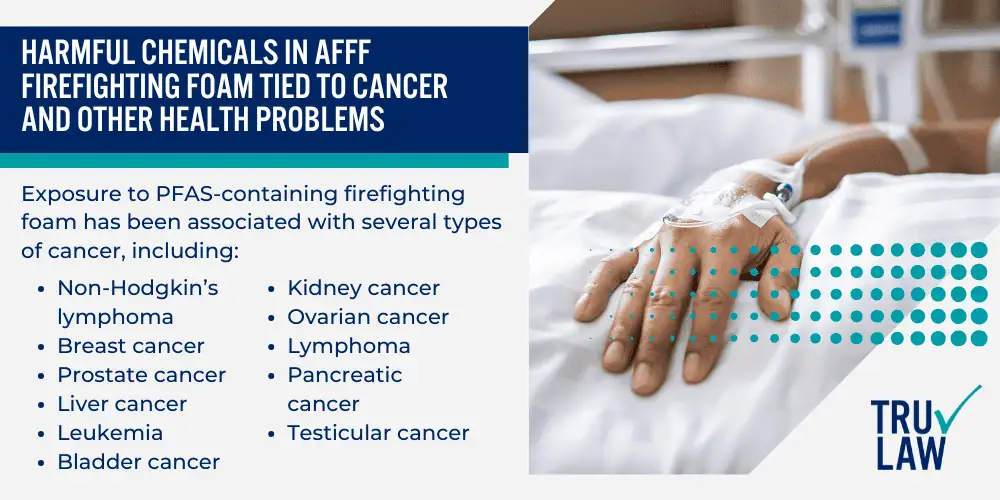
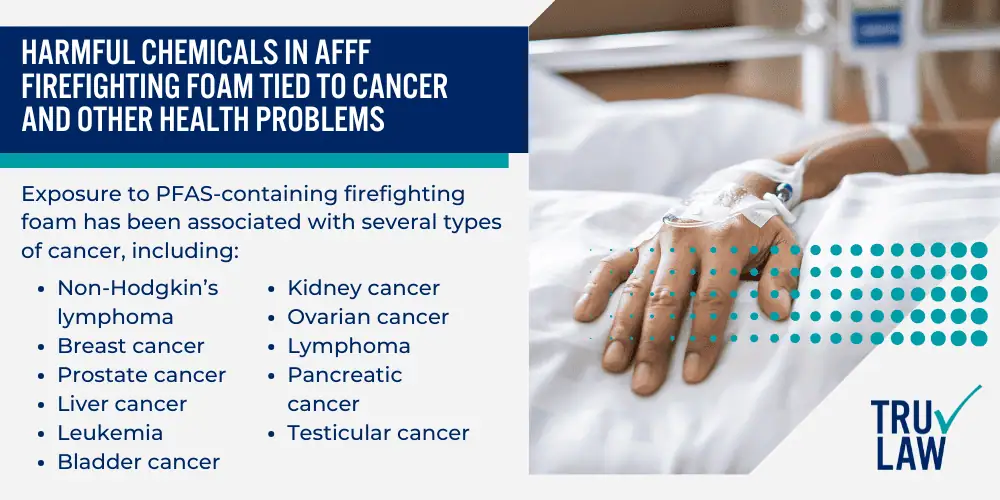
Exposure to PFAS-containing firefighting foam has been associated with several types of cancer, including:
- Non-Hodgkin’s lymphoma
- Breast cancer
- Prostate cancer
- Liver cancer
- Leukemia
- Bladder cancer
- Kidney cancer
- Ovarian cancer
- Lymphoma
- Pancreatic cancer
- Testicular cancer
Research has shown that high levels of PFAS exposure may lead to the following health concerns:
- Elevated cholesterol levels
- Altered liver enzyme function
- Increased risk of pre-eclampsia in pregnant women
- Slightly reduced birth weights in infants
- Lower vaccine responses in children
While there is still much to learn about the full range of PFAS-related health effects, scientific studies continue to explore the potential risks posed by these chemicals.
Many health, environmental, and governmental organizations are investigating these risks to better understand how to manage and regulate PFAS exposure.
Further actions are being taken, including initiatives by the National Firefighter Registry (NFR), which was established in 2018 by the National Institute for Occupational Safety and Health (NIOSH).
The registry aims to study the link between firefighters exposed to AFFF and the development of cancer, which will help us understand the true extent of these long-term health impacts.
Health Effects Following AFFF Firefighting Foam Exposure
Exposure to Aqueous Film Forming Foam (AFFF) can lead to a variety of side effects that impact different areas of the body.
The severity of these effects often depends on factors such as an individual’s sensitivity and the length of exposure.
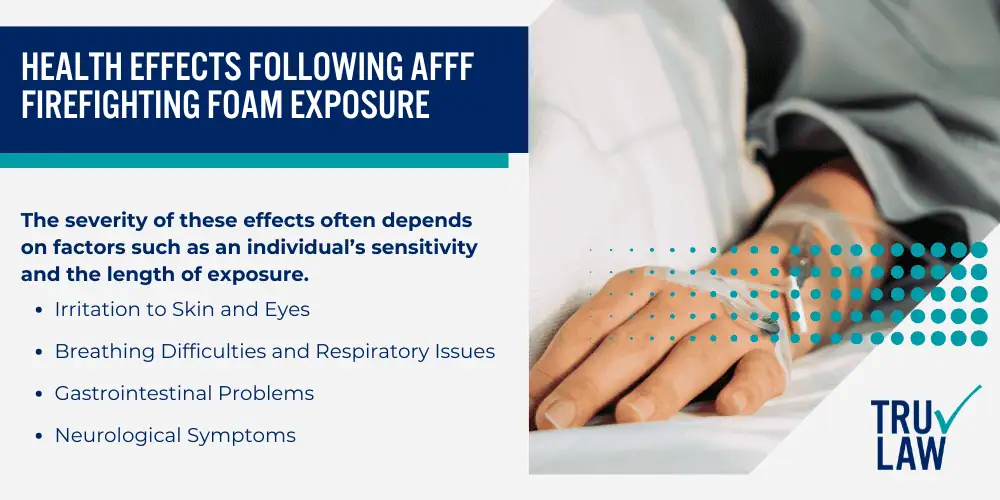
Irritation to Skin and Eyes
Direct contact with AFFF can result in skin irritation, causing redness, itching, and rashes.
In more severe cases, chemical burns may occur.
If AFFF comes into contact with the eyes, it can lead to irritation, redness, itching, and even temporary vision issues.
Breathing Difficulties and Respiratory Issues
Inhalation of AFFF foam or its vapors can irritate the respiratory system.
This may cause symptoms such as coughing, wheezing, chest tightness, and shortness of breath.
For individuals with pre-existing respiratory conditions, these symptoms could become more severe.
Gastrointestinal Problems
Accidentally ingesting water or food contaminated with AFFF can lead to gastrointestinal issues, including nausea, vomiting, abdominal pain, and diarrhea.
In cases of prolonged exposure, these symptoms may become chronic.
Immediate medical attention is advised if ingestion occurs, as internal damage is possible.
Neurological Symptoms
AFFF exposure may also result in neurological symptoms such as headaches, dizziness, memory loss, confusion, and difficulty concentrating.
In some cases, these symptoms can interfere with daily activities and reduce overall quality of life.
More severe or prolonged exposure may lead to lasting neurological effects.
Aqueous Film Forming Foam (AFFF) Exposure and Cancer Risk
Research has shown a connection between exposure to Aqueous Film Forming Foam (AFFF) and several types of cancer.
The chemicals in AFFF, particularly PFAS, have been linked to cancer development.
Understanding which cancers may result from AFFF exposure is important, as early detection and medical intervention can improve outcomes for those affected.
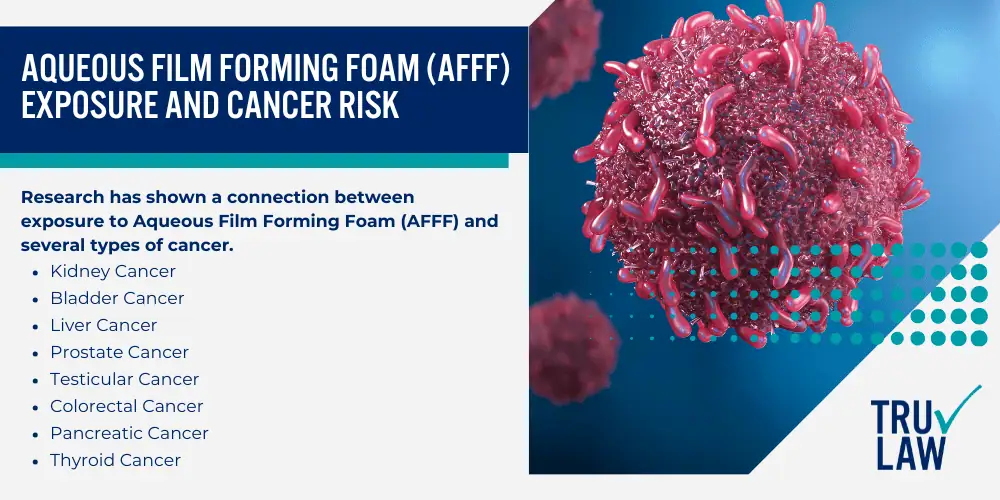
Kidney Cancer
There is evidence that AFFF exposure increases the risk of kidney cancer.
PFAS chemicals, present in AFFF, can accumulate in the kidneys over time, potentially leading to the formation of malignant tumors.
In a study published by the National Cancer Institute, individuals with higher levels of perfluorooctanoic acid (PFOA) in their blood were shown to have more than twice the risk of developing kidney cancer than those with lower concentrations.
Bladder Cancer
Prolonged exposure to PFAS chemicals in AFFF may also increase the likelihood of developing bladder cancer.
These toxic substances can build up in the bladder, causing cellular changes that may lead to cancer.
A 3M study found an increase in bladder cancer mortality among workers who were frequently exposed to perfluorooctane sulfonate (PFOS), a type of PFAS.
Liver Cancer
There is growing research suggesting a link between AFFF exposure and liver cancer.
The liver’s role in filtering toxins can be compromised by PFAS accumulation, leading to the potential for cancerous changes.
Some animal studies suggest that exposure to these chemicals can increase the risk of liver damage and hepatocellular carcinoma (HCC), particularly by disrupting key metabolic processes.
Prostate Cancer
PFAS exposure has been associated with a higher risk of prostate cancer in men.
While the exact mechanisms are still under investigation, the evidence indicates that PFAS chemicals may play a role in the development and progression of prostate tumors.
A study points to a powerful relationship between PFAS exposure and an increased risk of prostate cancer.
Testicular Cancer
Some studies have found a potential link between PFAS exposure and an elevated risk of testicular cancer.
For example, an ecological study found that men living in areas contaminated with PFAS had a higher likelihood of developing testicular cancer.
However, further research is needed to confirm this connection.
Colorectal Cancer
There is also evidence that AFFF exposure may increase the risk of colorectal cancer.
PFAS chemicals ingested through contaminated food or water can accumulate in the colon, potentially leading to the development of cancer cells.
A study showed that perfluorooctanoic acid (PFOA) could promote colorectal cancer cell invasion, suggesting a possible link between PFAS exposure and colorectal cancer.
Pancreatic Cancer
AFFF exposure has been associated with a higher risk of pancreatic cancer.
The accumulation of PFAS in the body may disrupt pancreatic function, potentially contributing to the onset of cancer.
A study published in Carcinogenesis found that perfluorooctanoic acid (PFOA) exposure could promote pancreatic cancer by increasing pancreatic intraepithelial neoplasia (PanIN), a precursor to cancer.
Thyroid Cancer
PFAS chemicals in AFFF have also been linked to thyroid cancer.
These substances can interfere with thyroid hormone production, potentially leading to cancer.
A study published in the Toxics journal highlights that PFAS exposure can alter thyroid hormone physiology and contribute to cancer development through immune system disruption and oxidative damage.
Non-Cancer Health Risks Linked to Toxic AFFF Firefighting Foam
In addition to the heightened risk of cancer, exposure to Aqueous Film Forming Foam (AFFF) can lead to a range of non-cancerous health effects.
These issues can greatly affect a person’s quality of life and overall well-being.
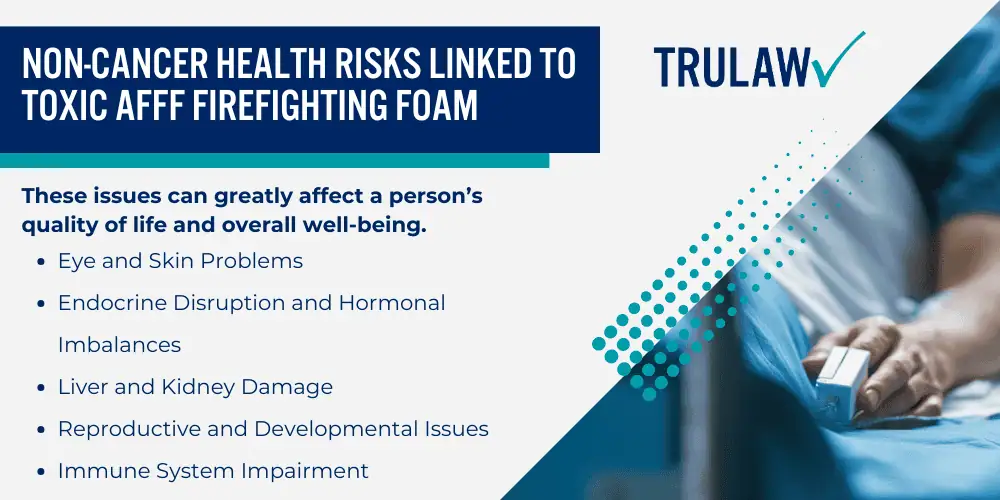
Eye and Skin Problems
Exposure to AFFF may result in various eye and skin conditions, depending on the duration and level of contact.
PFAS chemicals in AFFF can cause persistent eye irritation, including conjunctivitis, as well as skin issues like rashes, itching, and even chemical burns.
Continued exposure can lead to chronic dermatological discomfort and long-term skin problems.
Endocrine Disruption and Hormonal Imbalances
PFAS chemicals have been linked to endocrine disruption, which affects the body’s hormonal balance.
This can lead to fertility challenges, complications during pregnancy, and other hormone-related health problems.
The longer the exposure to these chemicals, the higher the risk of developing hormonal imbalances and related conditions.
Liver and Kidney Damage
Long-term exposure to AFFF can result in damage to the liver and kidneys, organs that play an important role in filtering toxins from the body.
Over time, the accumulation of PFAS chemicals can impair the function of these organs, potentially leading to irreversible health consequences if the damage is left untreated.
Reproductive and Developmental Issues
AFFF exposure may also affect reproductive health and the development of infants and children.
Studies suggest potential links between PFAS exposure and reduced fertility, adverse pregnancy outcomes, and developmental challenges in children.
These impacts can have lasting effects on both mothers and babies.
Immune System Impairment
PFAS chemicals found in AFFF can weaken the immune system, making individuals more prone to infections and autoimmune disorders.
Reduced immune function can increase the likelihood of developing various illnesses, and the extent of immune system damage may depend on the level and duration of exposure to these harmful chemicals.
Who is Impacted by AFFF Exposure?
Several groups of individuals face a heightened risk of PFAS exposure due to their occupations or proximity to locations where AFFF firefighting foam is regularly used.
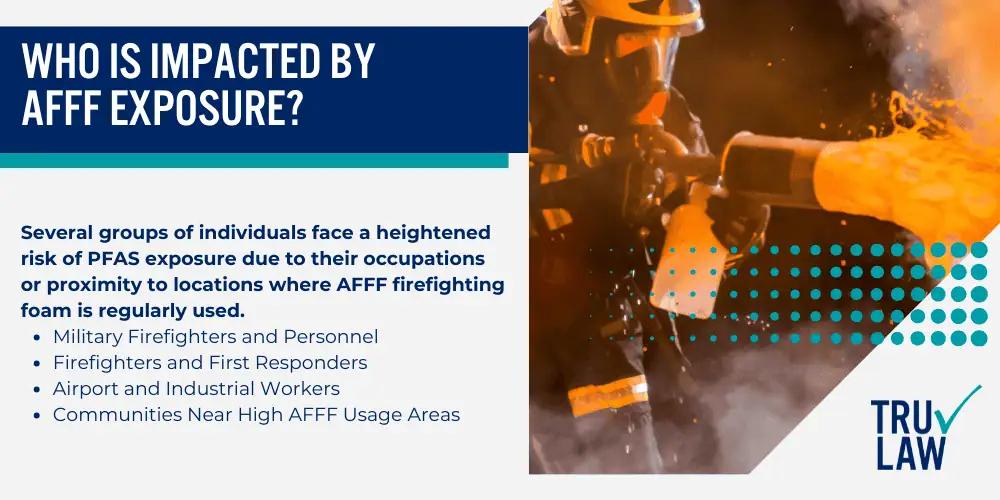
Military Firefighters and Personnel
The U.S. military played an important role in the development of aqueous film-forming foam (AF) in the 1960s, according to the National Fire Protection Association (NFPA).
Since then, military bases have utilized AFFF in both training exercises and operational settings.
As a result, military firefighters and other military personnel who were exposed to AFFF during their service may face an increased risk of developing health conditions associated with these chemicals.
Firefighters and First Responders
Civilian firefighters and first responders are also frequently exposed to AFFF during firefighting and emergency response situations.
While they are trained to use protective gear and follow safety measures, repeated and prolonged exposure to AF chemicals can still result in substantial health risks for firefighters.
Even with safety protocols in place, the toxic nature of AFFF can lead to severe health complications over time.
Airport and Industrial Workers
AFFF is commonly used in airports and industrial environments to manage fuel-based fires.
Workers in these settings — such as aircraft rescue personnel, industrial firefighters, and those in similar roles — may face substantial exposure to the toxic chemicals present in AFFF.
While safety precautions are necessary, the potential for exposure remains high in these professions.
Communities Near Areas With High AFFF Usage
Residents living near locations with frequent AFFF usage, such as fire training facilities, airports, chemical plants, or industrial sites, may experience indirect exposure.
This can occur through contaminated water sources or environmental pollution, as the chemicals from AFFF can enter rivers, lakes, and groundwater, or be released into the air.
The long-term effects of AFFF contamination can have serious health implications for these communities.
It’s important to note that TruLaw is only accepting clients with AFFF personal injury claims — we are not accepting clients for the AFFF municipal water contamination lawsuits.
Are You Eligible for the Firefighting Foam Lawsuit?
If you have been exposed to AFFF and subsequently developed cancer or other related illnesses, it’s important to explore your legal options.
Working with qualified AFFF attorneys can help you better understand your rights and take appropriate action.
The firefighting foam lawyers at TruLaw and our partner law firms have experience with AFFF-related claims and can help guide you through this challenging process.
We can assist with evaluating your potential claim, gathering the necessary evidence, and filing your claim in the AFFF MDL.

If you are eligible, you may be able to seek compensation for medical expenses, lost wages, and other damages resulting from AFFF exposure.
Use the chat on this page for an instant case evaluation to quickly determine if you qualify to file an AFFF lawsuit.
Latest Developments in AFFF Firefighting Foam Lawsuits
There are currently thousands of AFFF-related cases pending, with many individual lawsuits consolidated into multidistrict litigation (MDL).
The AFFF MDL is being overseen by the United States District Court for the District of South Carolina.
TruLaw: Your AFFF Firefighting Foam Law Firm
Exposure to aqueous film-forming foam (AFFF) has been linked to serious health risks, including an increased likelihood of developing cancer and other related illnesses.
If you’ve been exposed to AFFF and developed cancer or other health conditions, you may be eligible to file an AFFF lawsuit.
You can use the chatbot on this page to see if you qualify for an AFFF firefighting foam lawsuit instantly.
At TruLaw, we work to ensure that individuals affected by AFFF exposure receive expert guidance tailored to their unique situation.
While the legal process can be challenging, our team is committed to helping you explore your options.
For any additional information or to discuss your potential claim, don’t hesitate to reach out.
AFFF Lawsuit Frequently Asked Questions
-
What health issues and side effects are associated with AFFF exposure?
A number of side effects, health problems, and cancers have been associated with PFAS chemicals found in many AFFF firefighting foams.
Cancers linked to AFFF exposure include:
- Prostate cancer
- Colorectal cancer
- Liver cancer
- Bladder cancer
- Mesothelioma
- Breast cancer
- Kidney cancer
- Testicular cancer
- Pancreatic cancer
- Potentially other types of cancer
Other health problems include:
- Developmental issues
- Reproductive and fertility issues
- Skin and eye irritation
- Immune system deficiencies
- Other health concerns
These risks emphasize the serious dangers of AFFF exposure, especially for those who regularly worked with or near these products.
-
What is the AFFF lawsuit about?
AFFF lawsuits are legal claims filed against the manufacturers of toxic firefighting foam, alleging that exposure to AFFF has caused severe health problems.
These lawsuits assert that AFFF exposure led to cancer and other related health issues, and that the manufacturers failed to adequately warn users about the potential risks associated with their products.
The lawsuits are currently being handled through multidistrict litigation (MDL) in the US District Court for the District of South Carolina, allowing many cases to be processed more efficiently.
-
How do I know if I qualify to file an AFFF lawsuit?
If you were exposed to AFFF firefighting foam and later developed cancer or other related health problems, you may qualify to file an AFFF lawsuit.
For more information on your specific case, contact a firefighting foam attorney at TruLaw today for a free consultation with no obligation.
You can do so by using the chat on this page for an instant case evaluation to quickly see if you qualify to file an AFFF lawsuit.
-
What is the average AFFF lawsuit settlement?
There has not yet been a settlement in the AFFF firefighting foam lawsuits.
However, attorneys estimate that potential settlement amounts for AFFF lawsuits could range from $20,000 to $600,000 (or more), depending on the specific circumstances and strength of each case.
These estimates are not guarantees, but projections based on outcomes in previous mass tort cases, especially those involving cancer diagnoses from toxic exposures.
For more personalized information on what to expect in your case, we recommend consulting with the experienced AFFF lawyers at TruLaw and our partner law firms to explore potential outcomes for your firefighting foam lawsuit.
You can do so by using the chat on this page for an instant case evaluation to quickly see if you qualify to file an AFFF lawsuit.

Managing Attorney & Owner
With over 25 years of legal experience, Jessica Paluch-Hoerman is an Illinois lawyer, a CPA, and a mother of three. She spent the first decade of her career working as an international tax attorney at Deloitte.
In 2009, Jessie co-founded her own law firm with her husband – which has scaled to over 30 employees since its conception.
In 2016, Jessie founded TruLaw, which allows her to collaborate with attorneys and legal experts across the United States on a daily basis. This hypervaluable network of experts is what enables her to share the most reliable, accurate, and up-to-date legal information with our readers!
Additional AFFF Lawsuit resources on our website:
Here, at TruLaw, we’re committed to helping victims get the justice they deserve.
Alongside our partner law firms, we have successfully collected over $3 Billion in verdicts and settlements on behalf of injured individuals.
Would you like our help?
At TruLaw, we fiercely combat corporations that endanger individuals’ well-being. If you’ve suffered injuries and believe these well-funded entities should be held accountable, we’re here for you.
With TruLaw, you gain access to successful and seasoned lawyers who maximize your chances of success. Our lawyers invest in you—they do not receive a dime until your lawsuit reaches a successful resolution!
AFFF Lawsuit claims are being filed against manufacturers of aqueous film-forming foam (AFFF), commonly used in firefighting.
Claims allege that companies such as 3M, DuPont, and Tyco Fire Products failed to adequately warn users about the potential dangers of AFFF exposure — including increased risks of various cancers and diseases.
Depo Provera Lawsuit claims are being filed by individuals who allege they developed meningioma (a type of brain tumor) after receiving Depo-Provera birth control injections.
A 2024 study found that women using Depo-Provera for at least 1 year are five times more likely to develop meningioma brain tumors compared to those not using the drug.
Suboxone Tooth Decay Lawsuit claims are being filed against Indivior, the manufacturer of Suboxone, a medication used to treat opioid addiction.
Claims allege that Indivior failed to adequately warn users about the potential dangers of severe tooth decay and dental injuries associated with Suboxone’s sublingual film version.
Social Media Harm Lawsuits are being filed against social media companies for allegedly causing mental health issues in children and teens.
Claims allege that companies like Meta, Google, ByteDance, and Snap designed addictive platforms that led to anxiety, depression, and other mental health issues without adequately warning users or parents.
Transvaginal Mesh Lawsuits are being filed against manufacturers of transvaginal mesh products used to treat pelvic organ prolapse (POP) and stress urinary incontinence (SUI).
Claims allege that companies like Ethicon, C.R. Bard, and Boston Scientific failed to adequately warn about potential dangers — including erosion, pain, and infection.
Bair Hugger Warming Blanket Lawsuits involve claims against 3M — alleging their surgical warming blankets caused severe infections and complications (particularly in hip and knee replacement surgeries).
Plaintiffs claim 3M failed to warn about potential risks — despite knowing about increased risk of deep joint infections since 2011.
Baby Formula NEC Lawsuit claims are being filed against manufacturers of cow’s milk-based baby formula products.
Claims allege that companies like Abbott Laboratories (Similac) and Mead Johnson & Company (Enfamil) failed to warn about the increased risk of necrotizing enterocolitis (NEC) in premature infants.
Here, at TruLaw, we’re committed to helping victims get the justice they deserve.
Alongside our partner law firms, we have successfully collected over $3 Billion in verdicts and settlements on behalf of injured individuals.
Would you like our help?
